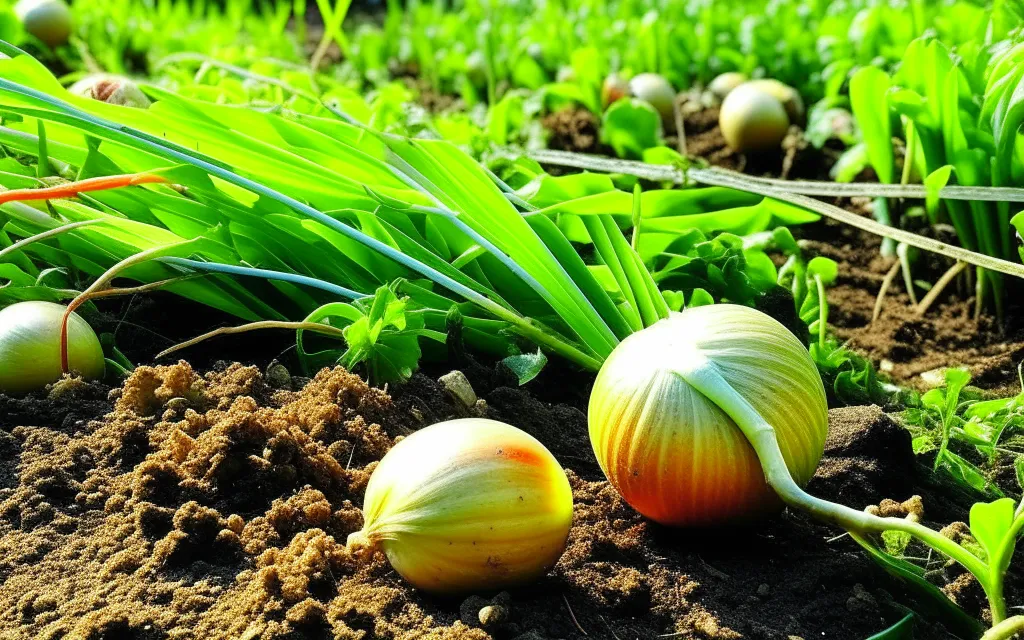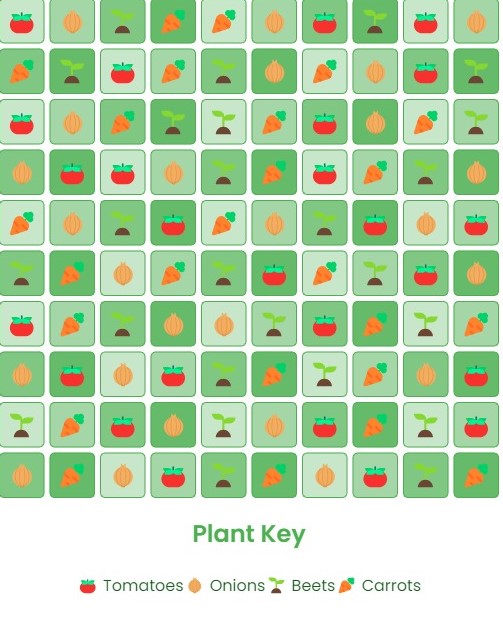
Companion Planting for Onions
Onions are one of those vegetables I just can’t get enough of. They’re full of flavor, add zest to nearly any dish, and, believe me, they’re pretty forgiving when it comes to growth. Whether you’re whipping up a sautéed medley or topping a burger, onions are an absolute must-have in the garden. Typically, these robust beauties thrive in full sun and well-drained soil, but we’ll dive deeper into that as we go!
Here is an example garden plan, made with our Free Companion Garden Planner. Click the image to try it for yourself.

Historically, onions have been cultivated for thousands of years. They were treasured by ancient Egyptians and have traveled across continents, becoming a staple in almost every cuisine. From sweet varieties that make your mouth water to pungent ones that bring tears to your eyes, there’s an onion for everyone.
You can grow onions in various ways, but let’s talk about the fun stuff! Have you ever tried vertical gardening? It’s become popular, and those nifty tower gardens make it possible to grow onions right in your kitchen! Of course, you can also plant them in your traditional garden bed, containers, or even raised beds. Plus, there are different variants, like yellow, red, and sweet onions, each with its unique flavor and culinary uses.

Benefits of Companion Planting for Onions
Okay, let’s chat about companion planting. If you’ve ever heard of it, you know it can transform your garden into a thriving ecosystem. But what are the benefits of companion planting for onions? Well, this technique isn’t just for beauty; it helps repel pests, improve growth, and enhance flavors. Plus, it can maximize space, which is a real boon for us backyard gardeners!
When I started companion planting, I was pleasantly surprised by how well my onions thrived alongside certain plants. It’s like a little community where everyone looks out for one another.
What are good companion plants for Onions?
If you’re wondering which plants can benefit your onions, let’s break it down. Here are a few of my favorite companions:
- Carrots: These two form a fantastic friendship! The scent of onions can deter pests that plague carrots, while carrots’ leafy greens provide a bit of shade and protect onions from the harsh sun. If you go for varieties like ‘Danvers’ or ‘Nantes,’ you’ll be in for a sweet treat.
Now, while those companions can foster growth, it’s crucial to know which plants to avoid.
Plants to Avoid
When it comes to companion planting, not all plants are created equal. You’ll want to steer clear of beans and peas when planting onions. These legumes can inhibit onion growth and lead to poor yields.
If you’ve grown beans or peas before, you know they can be quite bushy and take up space quickly. To keep your onions safe, it’s best to plant these bad boys at least 3 feet away from your onions, carrots, beets, and tomatoes—yes, three whole feet! This will reduce any growth competition and ensure your onions have the space they need to reach their full potential.
So, there you have it! Onions can be a joy to grow, especially when you embrace the magic of companion planting. By pairing them with carrots, beets, and tomatoes, you’ll see a boost in both growth and flavor. Just remember to give those pesky beans and peas a wide berth. With a little planning and care, your onion plants will flourish, and your culinary adventures will be all the more delicious. Happy gardening, and may your onion crop be bountiful!
Companion Planting with Onions: A Gardener’s Guide
Hey there, garden enthusiasts! If you’re like me, you’re always looking for ways to make your garden more productive and harmonious. Today, let’s dive into the world of companion planting, focusing on onions and their perfect plant pals. It’s a game changer! So grab your spade, and let’s get started!
General Spacing Rule
As a general rule of thumb, when planting carrots, beets, or tomatoes near onions, you’ll want to keep a spacing of about 6 to 12 inches between them. This distance helps each plant thrive without overcrowding. Remember, it’s all about giving them room to breathe and access nutrients!
Guidelines for Tall Companions
If you’re considering taller companions, think sunflowers or corn. Give them about 12 to 18 inches of space from your onions. Taller plants can create shade and offer protection without overshadowing your onions. Just make sure they’re not hogging all that valuable sunlight!
Guidelines for Low-Growing Companions
For low-growing buddies like lettuce or spinach, aim for around 6 to 8 inches of space. These leafy greens can thrive underneath taller plants’ canopies, boosting your garden’s productivity. It’s almost like having your very own plant community!
Guidelines for Strongly Aromatic Companions
When it comes to aromatic plants such as basil or rosemary, I recommend spacing them about 12 inches away from onions. Their scents can help deter pests, making them a perfect ally for your onion crop. Plus, who doesn’t love the aroma of fresh basil wafting through the garden?
Guidelines for Nutrient-Heavy Feeders
Nutrient-heavy feeders like cabbages and peppers should be planted about 12 to 24 inches away from onions. These are hungry plants that appreciate a little extra room to spread their roots and absorb nutrients. Just keep an eye on the veggies and make sure everyone’s getting their fair share!
Guidelines for Spreading or Vining Companions
If you’re opting for spreading or vining plants like cucumbers or squash, you’ll want to give them at least 24 to 36 inches of space. These plants have a knack for taking over, so letting them roam freely will keep the both of you happy. They can even provide some shade for your onions during the hotter months!
Adapting to Garden Conditions
As you plant your onion companions, remember that every garden is unique. Factors like soil quality, sunlight, and moisture can influence your spacing. Don’t hesitate to adjust your distances based on your specific conditions and the mature sizes of your plants.
Plant Summaries
Carrots
Carrots are pretty versatile! Besides onions, they grow wonderfully alongside radishes and peas. These combinations not only make the most of your space but also complement each other in taste and growing conditions. Just keep them at that cozy 6 to 12 inches apart to ensure a bountiful harvest.
Beets
Beets are delightful companions too. Along with onions, they thrive with crops like chard and cloves of garlic. Be sure to keep that 6 to 12 inches distance for the best results. It’s like creating an edible garden tapestry that benefits from everyone’s presence!
Tomatoes
Tomatoes love the company of onions, but they’re also good pals with peppers and basil. Make sure you give them at least 12 inches of space. This distance helps prevent blight and maximizes sunlight exposure. Plus, the combination of flavors is simply delectable!
And there you have it! Planning your garden layout with companion planting can be a fun and rewarding experience. Let each plant have its space and share a few tips with fellow gardeners along the way. Happy growing!

Leave a Reply